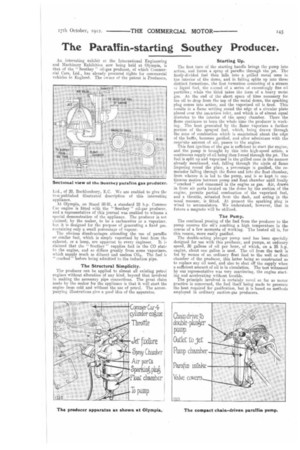The Paratfin-starting Southey Producer.
Page 19

If you've noticed an error in this article please click here to report it so we can fix it.
An interesting exhibit at the International Engineering and Machinery Exhibition now being held at Olympia, is that of the " Southey " oil-gas producer, of which Commercial Cars, Ltd., has already procured rights for eominercia vehicles in England. The owner of the patent is Producers Ltd., of 20, Elicidersbury, E.C. We are enabled to give the hist-publiehed illustrated description of this interesting appliance.
At Olympia, on Stand 89-91, a standard 25 h.p. Commer Car engine is fitted with the " Southey " oil-gas producer, and a representative of this journal was enabled to witness a special demonstration of the appliance. The producer is not claimed, by the maker, to be a carburetter or a vaporizer, but it is designed for the purpose of generating a fixed gas, containing only a small percentage of vapour.
The obvious disadvantages attending the, use of paraffin or similar fuel, which is simply vaporized by heat from the exhaust, or a lamp, are apparent to every engineer. It, is claimed that the " Southey " supplies fuel in the CO state to the engine, and so differs greatly from some vaporizers. which supply much as diluent and useless COs. The fuel is " cracked" before being admitted to the induction pipe.
The Structural Simplicity.
The producer can be applied to almost all existing petrol engines without alteration of any kind, beyond that involved in making the necessary pipe connections. The great claim made by the maker for the appliance is that it will start the engine from cold and without the use of petrol. The accompanying illustrations give a good idea of the apparatus, Starting Up.
The first turn of the starting handle brings the pump into action, and forces a spray of paraffin through the jet. The finely-divided fuel then falls into a grilled metal cone in tne interior of the dome, and in falling splits up into three distinct formations, the first formation consisting of a stream of liquid fuel, the second of a series of exceedingly fine oil particles ; while the third takes the form of a heavy moist gas. At the end of the short space of time necessary for the oil to drop from the top of the metal dome, the sparking plug comes into action, and the vaporized oil is fired. This results in a flame settling round the edge of a circular plate placed over the inaction inlet, and which is of almost equal diameter to the interior of the spray chamber. There the flame continues to burn the whole time the producer is working. The heat generated by the flame vaporizes a further portion of the sprayed fuel. which, being drawn through the zone of combustion which is maintained about the edge of the baffle, becomes gasified, and after admixture with the requisite amount of air, passes to the engine. This first ignition of the gas is sufficient to start the engine, and the pump is brought by this into high-speed action, a continuous supply of oil being then forced through the jet. The fuel is split up and vaporized in the grilled cone in the manner already mentioned, and, falling through the circle of flame lingerieg round the plate, a percentage is gasified, the remainder falling through the flame and into the float chamber, from whence it is led to the pump, and is so kept in continuous motion between pump and float, chamber until finally "cracked " and consumed in the engine as gas. Air, drawn in from air ports located on the dome by the suction of the engine, permits partial combustion of the vaporized fuel, and a throttle, actuated from the dash, and acting in the usual manner, is fitted. At present the sparking plug is wired to accumulators. We understand, however, that in future a magneto will be utilized.
The Pump.
The continual passing of the fuel from the producer to the pump ensures the oil's reaching a high temperature in the course of a few moments of working. The heated oil is, for this reason, more easily gasified.
The double-acting plunger pump used has been specially designed for use with this producer, and pumps, at ordinary speed, 30 gallons of oil per hour, of which, on a 25 h.p. engine, about one gallon is used. The oil from the tank is fed by means of an ordinary float feed to the well or float chamber of the producer, this latter being so constructed as to replace any oil used, and also to shut off the supply when a sufficient amount of oil is in circulation. The test witnessed by our representative was very convincing, the engine starting and accelerating without trouble.
The principle involved is certainly novel so far as motor practice is concerned, the fuel itself being made to generate the heat required for gasification, but it is based on methods employed in ordinary suction-gas producers.




























